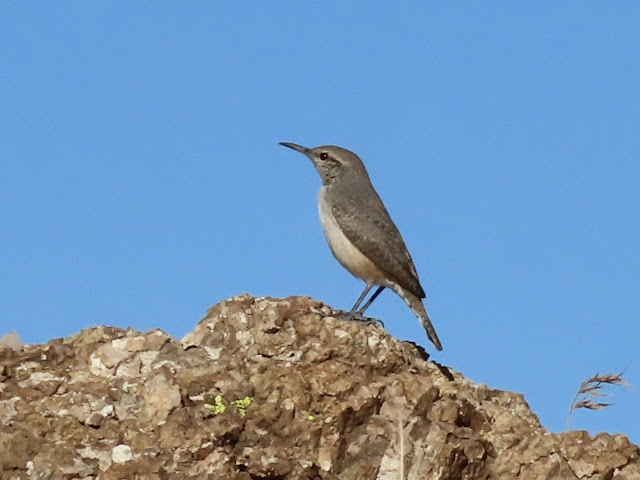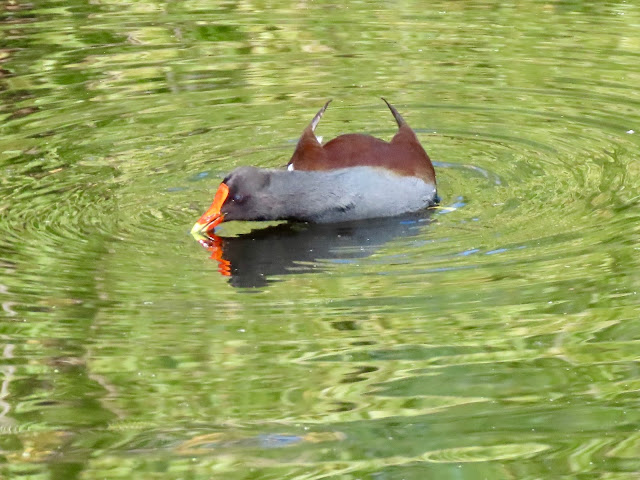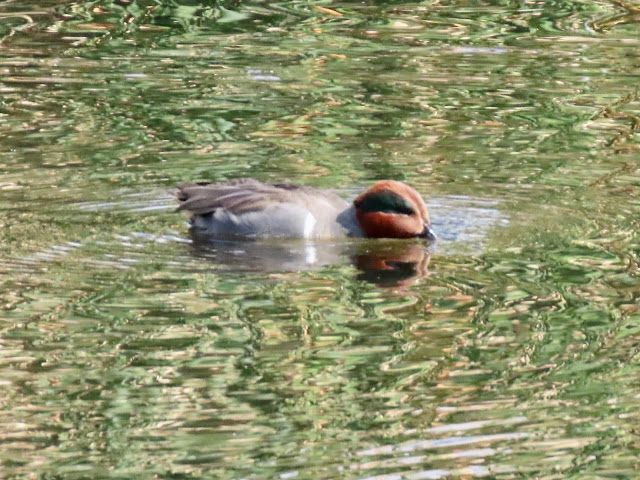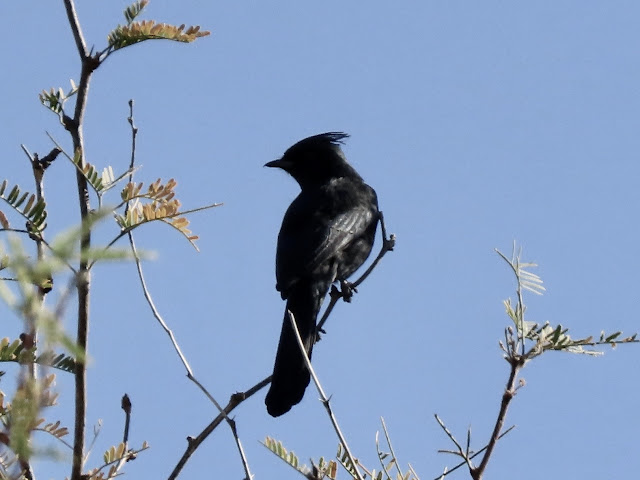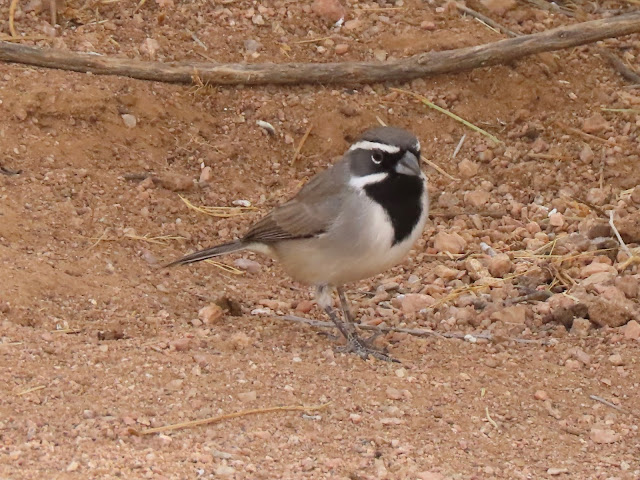Thursday, October 22, 2020
Beginning at 7:12 a.m. in the parking lot of the Arboretum in Superior, Hinde Silver and I managed to explore new and well-known areas of the desert habitat for more than three hours over 3.5 miles of walking. Temperatures between 59-81°F were welcome after a very hot and long summer.
With the Chinese Pistachio tree berries not quite ripe, we did not expect the congregation of birds that filled the tree. Next visit, I'll bring a chair!! Not the only ones delighted to see so many songbirds in the tree, a HARRIS'S HAWK tried its best to camouflage itself.
The several HERMIT THRUSH, an AMERICAN ROBIN and other songbirds were well aware of the hawk's presence and were circumspect about their positions in the tree. It was when Hinde and I walked up that the HARRIS'S HAWK took off to perch beyond the picnic area across Queen Creek.Meanwhile the displaced HARRIS'S HAWK looked none too happy out on its perch:
Spending much time at the "berry" tree in the picnic area, we decided to expand our time in that direction to cover the Demonstration Garden and introduce Hinde to the Wallace Garden.
Hinde went ahead while I checked the west side of the Demo Garden for some reported birds. The TOWNSEND'S WARBLER showed itself, but I wasn't quick enough with the camera before it took off. I had little hope of locating the reported CALLIOPE HUMMINGBIRD. But as I approached the entrance to the Wallace Garden -OMG! - exploding from a bed of flowering ground cover, a very small hummingbird zipped up and across the Demo Garden faster than I could say, "CALLIOPE"! It's dark green back and small size - slightly longer than my little finger - identified it: smaller than an Anna's, or Broad-Billed, or Rufous Hummingbird, the beautiful CALLIOPE is in a class by itself around here. A male had been reported in the Demo Garden; I didn't see its gorgeous gorget.
CALLIOPE HUMMINGBIRD (male) [file photo taken 2016, Portal, AZ]
We continued to see more birds throughout the remainder of our wanderings but I held back on photos of more common species. We did see many HERMIT THRUSH in various places so it felt good to see them again.
View this checklist online at https://ebird.org/checklist/S75222935
Saturday, October 24, 2020
While Lois Lorenz and I had planned to go to the River, a rare and beautiful bird had just been reported at Gilbert Water Ranch, so we chose that location. Lois grew up seeing that bird in New Jersey so she was less persistent than I in wanting to see and photograph the male BLACK-THROATED BLUE WARBLER. [The first time I saw it in Canada with Glenda, I almost fainted! It was at eye level with the sun shining on it and it just perched and looked directly at us.]
More birders arrived prepared with long-lens cameras that would capture the great shots; I could only hope for "decent" with the BLACK-THROATED BLUE foraging from one limb to another in a large Cottonwood tree. I didn't even manage that: all I got were leaves. With it having just been reported, I convinced myself the bird would hang around until it filled up to continue its migration and I rejoined Lois in covering a bit more of the Water Ranch.
Best birds I found:
1). OSPREY
2) female NORTHERN HARRIER flying low over the dry areas of one of the ponds.
Many more species of birds in this habitat that has been attracting migrants all season can be viewed by clicking on my eBird link below.
View this checklist online at https://ebird.org/checklist/S75299594
Tuesday, October 27, 2020
A return visit to the Water Ranch was important to me. The BLACK-THROATED BLUE WARBLER was still being reported at the same general location I had viewed it briefly on Saturday. Today, I was arriving late, after an appointment in Phoenix and hoped the bird would have conquered its early-morning hunger and make itself more available to visitors, as others' photos suggested.
Whoa! Such indescribable luck! The bird was not only low in the trees, it appeared to be playing our game: "Here's looking at you!" We looked; it looked. Sometimes it flew; other birders gasped when it aimed for my head! I was the only one not aware! Soon, I just sat down on the dusty trail to be at a level with the BLACK-THROATED BLUE. [I can't hold myself stable enough anymore with kneeling and squatting.] What fun!
Where it walked right up to my shoe
View this checklist online at https://ebird.org/checklist/S75489173
Thursday, October 29, 2020
Hinde had also made a special trip to the Water Ranch to photograph the BLACK-THROATED BLUE WARBLER as it was a LIFE BIRD for her, meaning the first time she ever saw it.
So, we chose Phon D. Sutton, along the Lower Salt River that I rarely cover in my birding ventures as it can be risky with loose gravel, etc., etc. With someone along to bird, it worked well. While we saw a number of distant birds that I didn't photograph, they were still memorable.
There was one SORA swimming; two ROADRUNNERS being curious; three WILSON'S SNIPE foraging in the muddy area, and I suppose I should add: one AMERICAN KESTREL on top of a Mesquite tree!
The first GREATER ROADRUNNER we spotted was very close to a chipper truck where the grinder was taking brush from the workers and sending the chips up into the truck. Whether it was noise or the action that attracted the bird, I'm not certain. But I found it trying to look into the truck (too high) and then looking under it. I mentioned to the two men talking on the opposite side of the truck about the Roadrunner and when they also looked, it wandered off just a bit and then just a bit more. Often, they are very skittish.
We had already birded the Salt River and were on our way to the west-side Nature Trail that took us across two parking lots. At the first large one, two young women were talking with one another and I noticed what appeared to be a young GREATER ROADRUNNER standing with them! As we got closer, I asked Hinde to stop but she proceeded. It made no difference; the Roadrunner didn't move!
It had begged food from the two young women. I reinforced to them feeding wild birds/animals is not a good idea but was informational about it, not rejecting their good intentions.
When a ROADRUNNER is cold, it will drop its wings to allow the sun to heat up its downy feathers.
All warmed up and toasty, the GREATER ROADRUNNER provided us with an excellent photo
To view our full list of birds at Phon D Sutton Rec area, click on the link below:
View this checklist online at https://ebird.org/checklist/S75561775
Monday, November 2, 2020
Having completed my outdoor chores and not wanting to stay inside all morning, I decided to check out the birds at our city park in AJ, Prospector Park. Good choice!One of the first birds I saw were a pair of WESTERN BLUEBIRDS. The female liked the shadows of the wash and hung out there so it was the male that came up to check me out while it foraged. It was overcast at that hour (8:30-9:30 a.m.), so pictures are what they are.
I could almost hear the brakes squealing on this turn. Did it hear the female?
No whole flocks of migrating sparrows remained, but a few individuals were out and about.
SAVANNAH SPARROW - above & below
When I was photographing a WHITE-CROWNED SPARROW, who should wander out from under a bush but a BLACK-THROATED SPARROW, another one of my favs. Both species below.White-crowned Sparrow (Gambel's subspecies)
Black-throated Sparrow
Numerous CACTUS WRENS, GILA WOODPECKER, GAMBEL'S QUAIL and other birds were present as well. I like to check the nearby parks to be sure our birds are still visiting and doing okay. It's probably just us humans that are wigged out right now as we deal with the knowns and unknowns of the Covid-19 pandemic and an Election Day tomorrow to decide whether we will have a stable mature man (Biden) as President or the volatile, decadent, narcissistic man that currently holds that position. Nature is always my salve in tough times; and it has taught me much. Gracias.
* * *
View this checklist online at https://ebird.org/checklist/S75741559







